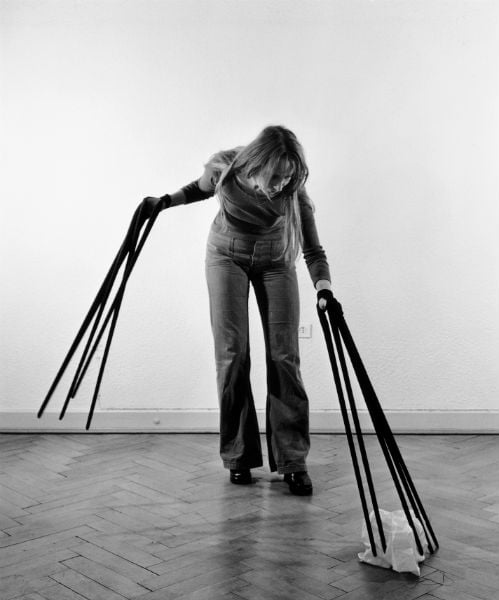
It’s an age-old practice: throughout history human beings have sought to extend and enhance their bodies. From today, a major exhibition in Leed’s Henry Moore Institute will explore the relationship between visual art and prosthetics.
Yael Bartana, Entartete Kunst Lebt (2010) video still. Courtesy of Annet Gelink Gallery, Amsterdam, and Sommer Contemporary Art, Tel Aviv.
“The Body Extended: Sculpture and Prosthetics,” curated by Lisa Le Feuvre, traces the artistic and surgical evolution of artificial body parts, gathering over 70 artworks, objects and images exploring the history of prostheses in the realms of sculpture and medical science, as well as exploring artists’ responses to the various conundrums they pose.
Matthew Barney, The Cabinet of Bessie Gilmore (1999). Copyright Matthew Barney, courtesy of the artist and Gladstone Gallery, New York and Brussels.
Prosthetics technology took off in earnest in the aftermath of the First World War, as artificial limbs needed to be developed for those wounded in war. After 1914, according to the Henry Moore Institute, over 41,000 veterans in the UK had lost a limb, and in Germany one in every 16 citizens would have sustained a major injury.
Captain Francis Derwent Wood RA of the Royal Army Medical Corps holds an artist’s palette as he adds the finishing touches to a patient’s new facial plate. Photo by Horace Nicholls, c1914–8 ©IWM, courtesy the Imperial War Museum, London, originally from the Ministry of Information collection titled The Development of Reconstructive Plastic.
Prostheses were initially uncomfortable and impractical, but surgeons worked with artists to respond to this and other problems. Sculptor Anna Coleman Ladd, for example, worked directly with surgeons to craft facial masks for soldiers injured in the trenches.
As a result, prosthetic technology gradually improved with some present day versions, such as those used by para-athletes, actually exceeding natural human capability.
Painted metal facial prosthesis attributed to Anna Coleman Ladd (1878-1939), made in France, 1917-192. Courtesy of the Antony Wallace Archives of the British Association of Plastic, Reconstructive and Aesthetic Surgeons.
In contrast, the artist Jacob Epstein visits the horror of a possible future where man and machine are no longer distinct.
The augmented body has been represented in culture as a both a symbol for the growing possibilities of the human race as well as a potentially nefarious threat to the future of humankind.
Heinrich Hoerle ‘Denkmal der unbekannten Prothesen’ (‘Monument to Unknown Prostheses’), 1930. Oil on cardboard 66.6 x 82.5cm Courtesy of Medienzentrum, Antje Zeis-Loi / Von der Heydt-Museum Wuppertal.
Alongside examples of prostheses from the collections of the Freud Museum, Hunterian Museum, Imperial War Museum (all three in London), and Thackray Medical Museum in Leeds, the exhibition also features works by Matthew Barney, Yael Bartana, Louise Bourgeois, and Rebecca Horn.
Louise Bourgeois, Henriette (1985). Courtesy Hauser & Wirth and Cheim & Read. Photo Christopher Burke © The Easton Foundation/VAGA, New York/DACS, London 2016.
A new sculpture by Rebecca Warren—co-commissioned with 14–18 NOW, the UK-based arts program for the First World War centenary—stands outside the Institute. The heavy, raw bronze sculpture is made up mainly of muscled legs and is set on a rudimentary bronze wheeled platform, as if taking a giant stride.
“The Body Extended: Sculpture and Prosthetics” is on view at the Henry Moore Institute, Leeds, from July 21 – October 23, 2016.